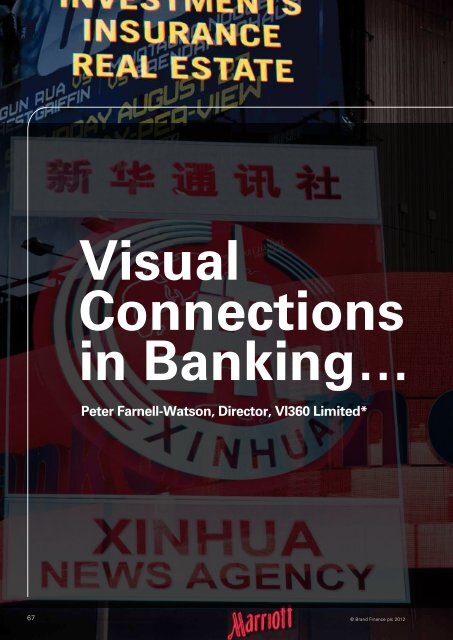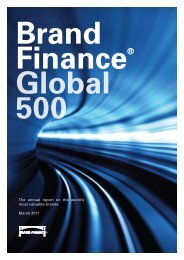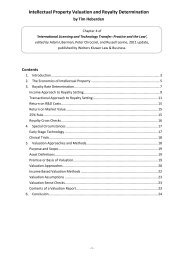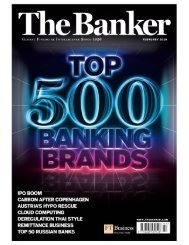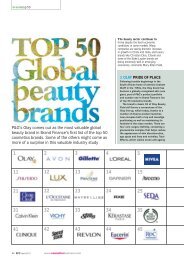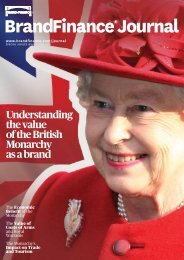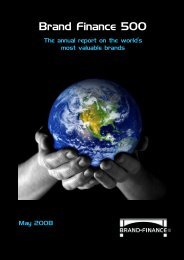The annual report on the world's most valuable ... - Brand Finance
The annual report on the world's most valuable ... - Brand Finance
The annual report on the world's most valuable ... - Brand Finance
Create successful ePaper yourself
Turn your PDF publications into a flip-book with our unique Google optimized e-Paper software.
Visual<br />
c<strong>on</strong>necti<strong>on</strong>s<br />
in Banking…<br />
Peter Farnell-Wats<strong>on</strong>, director, Vi360 limited*<br />
Have you ever c<strong>on</strong>sidered how people c<strong>on</strong>nect<br />
and associate <strong>the</strong>mselves in <strong>the</strong> <strong>most</strong> primary and<br />
fundamental way with <strong>the</strong>ir nati<strong>on</strong>ality, religi<strong>on</strong><br />
or favourite sporting team?<br />
Is it <strong>the</strong> an<strong>the</strong>m, prayer or <strong>the</strong> sporting chant?<br />
Or is it <strong>the</strong> texture of <strong>the</strong> countryside, <strong>the</strong> experience<br />
of participati<strong>on</strong>, or <strong>the</strong> aura of <strong>the</strong> home game?<br />
<str<strong>on</strong>g>The</str<strong>on</strong>g> answer perhaps is a hard-wired c<strong>on</strong>necti<strong>on</strong><br />
with some basic and very specific visual cues -<br />
colours and shapes in flags for nati<strong>on</strong>s, ic<strong>on</strong>ography<br />
for religi<strong>on</strong>, and names, symbols and colours for<br />
sporting teams. It’s a sort of indispensible visual<br />
heritage that over time has been burned into<br />
<strong>the</strong> subc<strong>on</strong>scious.<br />
While <strong>the</strong> fundamentals are <strong>the</strong>re, <strong>the</strong> challenge of<br />
maintaining visual c<strong>on</strong>tinuity today is becoming more<br />
complex, with nati<strong>on</strong>s now adopting brands and<br />
logotypes to promote tourism, religi<strong>on</strong> has become<br />
more visual to retain and regain c<strong>on</strong>gregati<strong>on</strong>s, and<br />
sporting teams now have a raft of various different<br />
strips and sp<strong>on</strong>sors too.<br />
<str<strong>on</strong>g>The</str<strong>on</strong>g> challenge is <strong>the</strong>re, but people are becoming<br />
more sophisticated and in tune with all this - where<br />
<strong>the</strong>y can dial out <strong>the</strong> peripheral and less important<br />
visual cues and focus <strong>on</strong> <strong>the</strong> key <strong>on</strong>es which <strong>the</strong>y<br />
have stored in <strong>the</strong>ir minds to maintain <strong>the</strong> c<strong>on</strong>necti<strong>on</strong><br />
with <strong>the</strong>ir team.<br />
But <strong>the</strong> story does not stop here. As teams and<br />
organisati<strong>on</strong>s c<strong>on</strong>tinue to evolve and forge new<br />
relati<strong>on</strong>ships, supporters have to update <strong>the</strong>ir visual<br />
reference memory banks in order to keep abreast<br />
with recogniti<strong>on</strong>.<br />
What about banks? Does this thinking relate to<br />
<strong>the</strong>m too? What is <strong>the</strong> basic c<strong>on</strong>necti<strong>on</strong> between<br />
customers and <strong>the</strong>ir banks, and how do potential<br />
customers know which bank is which?<br />
While <strong>the</strong> experts will <strong>most</strong> likely answer that<br />
it is <strong>the</strong> mighty brand, and perhaps <strong>the</strong> newer<br />
c<strong>on</strong>cept of ‘reputati<strong>on</strong>’, that really makes <strong>the</strong><br />
difference, it would seem that <strong>the</strong> humble visual<br />
identity (which experts will agree is wrapped up and<br />
part of <strong>the</strong> brand) is al<strong>most</strong> taken for granted.<br />
While <strong>the</strong>re is excitement when a bank adopts<br />
a new or revised visual identity, what happens<br />
five years later when <strong>the</strong> bank still looks largely<br />
<strong>the</strong> same?<br />
Should all aspects of <strong>the</strong> visual wrapping paper<br />
and face of <strong>the</strong> bank be kept <strong>the</strong> same, or should<br />
parts of it play a str<strong>on</strong>ger and more dynamic role<br />
in attracting, forging and keeping relati<strong>on</strong>ships<br />
with customers? Experts will say that brands need<br />
to be differentiated and kept relevant in order<br />
to keep abreast and ahead of market needs. So too<br />
must brands evolve <strong>the</strong>ir visual identities.<br />
Banks operate in <strong>the</strong> retail and service sector,<br />
but unlike shops, where <strong>the</strong>y can be kept fresh<br />
indirectly through new visual merchandise, banks<br />
have no chance to use <strong>the</strong> same opportunity to keep<br />
up to date in <strong>the</strong>ir customer’s minds.<br />
With <strong>the</strong> reputati<strong>on</strong> of banks being at <strong>the</strong>ir lowest<br />
for many years and with <strong>the</strong> likelihood of regulatory<br />
changes in <strong>the</strong> future, it would seem that banks<br />
must find a way to repositi<strong>on</strong> <strong>the</strong>mselves and<br />
to develop <strong>the</strong>ir identities in such a way that <strong>the</strong><br />
key visual elements can c<strong>on</strong>tinually evolve and work<br />
for <strong>the</strong>m in being attractive, fresh and relevant.<br />
Banks have come some way since <strong>the</strong>ir old sign<br />
shingles which used to adorn <strong>the</strong>ir buildings<br />
in <strong>the</strong> City of L<strong>on</strong>d<strong>on</strong> (Eagle for Barclays Bank,<br />
Griffin for Midland Bank, etc), but with <strong>the</strong> visual<br />
sophisticati<strong>on</strong> and appetite of c<strong>on</strong>sumers changing<br />
so quickly, <strong>the</strong> use of electr<strong>on</strong>ic media playing more<br />
of a role in maintaining and developing relati<strong>on</strong>ships<br />
with customers and o<strong>the</strong>r financial and n<strong>on</strong>-financial<br />
newcomers coming into <strong>the</strong> market, <strong>the</strong> role<br />
of visual identity will need to work much harder<br />
for Banks just to stay abreast in <strong>the</strong> brand<br />
preference stakes.<br />
So think about this as viewers around <strong>the</strong> world<br />
watch <strong>the</strong>ir teams participate in <strong>the</strong> 2012 L<strong>on</strong>d<strong>on</strong><br />
Olympics Games and how basic visual elements can<br />
play such an important and str<strong>on</strong>g role in identifying<br />
and c<strong>on</strong>necting people.<br />
But also c<strong>on</strong>sider how in this fast changing world<br />
whe<strong>the</strong>r a passive visual identity is going to be<br />
enough to do <strong>the</strong> business of identifying, attracting<br />
and retaining customers for banks.<br />
*VI360 is part of <strong>the</strong> <strong>Brand</strong> <strong>Finance</strong> family<br />
67 © <strong>Brand</strong> <strong>Finance</strong> plc 2012<br />
© <strong>Brand</strong> <strong>Finance</strong> plc 2012<br />
68


